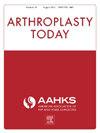翻转技术对侧卧位患者使用便携式髋关节导航系统测量髋臼杯位置精度的影响
IF 2.1
Q3 ORTHOPEDICS
引用次数: 0
摘要
背景:在全髋关节置换术后,为了获得满意的结果,需要进行准确的假杯放置。便携式髋部导航系统是一种新颖的术中工具,可精确放置护杯。据报道,有几个因素会影响其准确性,包括翻转技术,其中骨盆参考平面在仰卧位登记,随后将患者重新定位到侧卧位进行手术。翻转技术的有效性仍然是一个有争议的话题。因此,本研究评估并比较了在侧卧位下使用惯性便携式髋关节导航系统测量杯位的准确性。方法对78髋进行测量准确性评估。采用相同的方法登记骨盆参考平面,比较了该系统与不使用翻转技术的准确性。术中系统显示的杯角与术后测量的杯角进行比较。结果使用和不使用翻转技术的测量误差分别为杯外展3.7°±2.8°和2.8°±2.6°(P = 0.029),杯前倾2.9°±2.5°和3.9°±2.9°(P = 0.037)。该系统在有和没有翻转技术的情况下,97%和98%的髋部杯外展(P = .636)和99%和96%的髋部杯前倾(P = .364)的测量误差在10°以内。结论无论是否使用翻转技术,该系统均可提供可靠的术中杯位测量。然而,不使用翻转技术时,杯外展测量更准确,而使用翻转技术时,杯前倾测量更准确。本文章由计算机程序翻译,如有差异,请以英文原文为准。
Effects of the Flip Technique on Measurement Accuracy of the Acetabular Cup Position Using a Portable Hip Navigation System With Patients in the Lateral Decubitus Position
Background
Accurate cup placement is performed for achieving satisfactory outcomes after total hip arthroplasty. Portable hip navigation systems are novel intraoperative tools for accurate cup placement. Several factors have been reported to affect their accuracy, including the flip technique, in which the pelvic reference plane is registered in the supine position and the patient is subsequently repositioned to the lateral decubitus position for surgery. The effectiveness of the flip technique remains a subject of debate. Therefore, this study assessed and compared the accuracy of cup position measurements using an inertial portable hip navigation system in the lateral decubitus position.
Methods
Measurement accuracy was assessed in 78 hips. The accuracy of the system was compared with and without the flip technique, employing an identical method for registering the pelvic reference plane. Cup angles displayed on the system during surgery were compared with those measured postoperatively.
Results
Measurement errors with and without the flip technique were 3.7° ± 2.8° and 2.8° ± 2.6° for cup abduction (P = .029) and 2.9° ± 2.5° and 3.9° ± 2.9° for cup anteversion (P = .037). The system achieved measurement errors within 10° in 97 and 98% of hips for cup abduction (P = .636), and 99 and 96% of hips for cup anteversion (P = .364) with and without the flip technique.
Conclusions
This system provided reliable intraoperative measurements of cup positions, irrespective of the use of the flip technique. However, cup abduction measurements were more accurate without the flip technique, while cup anteversion measurements were more accurate with the flip technique.
求助全文
通过发布文献求助,成功后即可免费获取论文全文。
去求助
来源期刊

Arthroplasty Today
Medicine-Surgery
CiteScore
2.90
自引率
0.00%
发文量
258
审稿时长
40 weeks
期刊介绍:
Arthroplasty Today is a companion journal to the Journal of Arthroplasty. The journal Arthroplasty Today brings together the clinical and scientific foundations for joint replacement of the hip and knee in an open-access, online format. Arthroplasty Today solicits manuscripts of the highest quality from all areas of scientific endeavor that relate to joint replacement or the treatment of its complications, including those dealing with patient outcomes, economic and policy issues, prosthetic design, biomechanics, biomaterials, and biologic response to arthroplasty. The journal focuses on case reports. It is the purpose of Arthroplasty Today to present material to practicing orthopaedic surgeons that will keep them abreast of developments in the field, prove useful in the care of patients, and aid in understanding the scientific foundation of this subspecialty area of joint replacement. The international members of the Editorial Board provide a worldwide perspective for the journal''s area of interest. Their participation ensures that each issue of Arthroplasty Today provides the reader with timely, peer-reviewed articles of the highest quality.
 求助内容:
求助内容: 应助结果提醒方式:
应助结果提醒方式:


